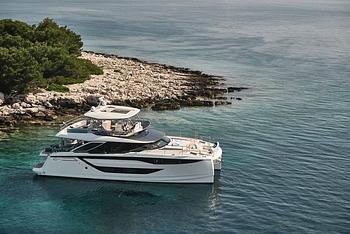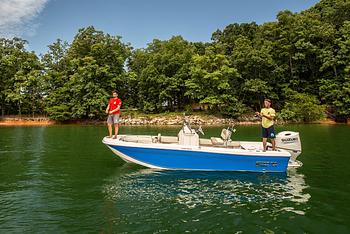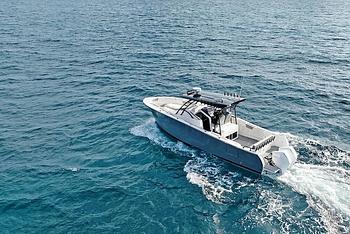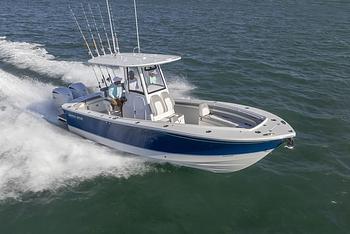Marine binoculars are a critical tool to have aboard a boat, but all boat binoculars are not created equal. In fact, some binoculars are little more than glorified toys that will prove more frustrating than beneficial whether you’re trying to find a distant buoy or spot wildlife from your boat. Others are technologically advanced and boast amazing optics, but cost as much as a small boat. Which binoculars will prove to be best aboard your boat? That’s for you to decide, but we can arm you with all the information you need to make the decision.

On a day when the choppy seas made it hard to take a picture with a straight horizon, using a good pair of marine binoculars makes a big difference.
Critical Features of Binoculars
Binoculars are a parallel pair of magnifying scopes that are connected to comfortably fit the human pair of eyes. Many modern designs are hinged in the middle to allow adjustment to best fit each individual person. Unlike single-cylinder scopes, which can also magnify, binoculars allow a person to retain perspective and three-dimensional imagery. They can range from pocket-sized models that provide minimal magnification to large, heavy models that require the use of a tripod for extended use.
The level of magnification is, naturally, a critical feature for any pair of binoculars, and it’s the first specification usually given. One would think initially that more is better, but this is only true up to a point (which we’ll learn more about in a moment). Objective lens diameter is usually considered the second-most important specification of a pair of binoculars, and is the second number you’ll see expressed. The objective lens diameter dictates how much light can be gathered, which in turn affects the image’s sharpness and brightness. While binoculars come in all kinds of shapes and sizes, the most common marine binoculars you’ll see will be rated as 7 x 35 with the 7 being magnification and the 35 being objective lens diameter.
Focus and eyepiece functions of binoculars are other factors that deserve consideration. Most people favor having a single wheel or lever that focuses both lenses together (usually with an eyepiece diopter that can be adjusted for each user’s personal need), but some people do prefer independent focus. Either way, it’s important to look for internal focusing abilities as opposed to external focusing when it comes to boat binoculars. External focusing moves external pieces and parts, which invites water and dust intrusion. Naturally, considering the marine environment, this can prove problematic.
Optical coatings also deserve a mention. Coatings can be used to enhance light transmission, reduce glare, protect the lenses, and for a host of other purposes. However, they’re seen so commonly on modern binoculars, and in so many different forms, that it’s not safe to make any judgements about what you might see in marketing materials or advertisements. As far as coatings go, the best way to judge their effectiveness is with your own eyes, looking through the lenses.
Finally, consider the field of view. This describes how large an area you’ll be seeing at 1,000 yards. Unless it’s very restrictive compared to other binoculars, this detail usually won’t come into play when deciding which specific pair to choose.

Image stabilized binoculars like these Nikon StabilEyes can allow you to see radically farther into the distance. Nikon photo.
Marine Binoculars for Boats
OK. Now that we know the basics about binoculars, what makes a pair perfect for use on a boat? Marine binoculars do have a long list of special requirements. They need to be waterproof and airtight; look for those that are nitrogen- or argon-filled so they don’t fog up inside. They should have some form of shock-absorbing rubberized armor so they don’t go caput the first time someone drops them on the deck. And they should be as light as possible, so you don’t wear out after a few minutes of scanning the horizon. Most important of all, however, is magnification.
This is where the more-is-better theory doesn’t always pan out. The more a pair of binoculars magnifies your focal point, the more it magnifies motion. Hand-jitters alone are enough that very high-power binoculars are best used with tripods, but on a boat you now have the added motion of the deck to contend with. Get a pair of binoculars that’s too potent, and you’ll be unable to use them effectively on all but the calmest of days. As a general rule of thumb, the majority of the binoculars designed specifically for use on boats stop at seven times magnification. There is, however, one glaring exception: stabilized binoculars.

Marine binoculars like this pair from West Marine must be waterproof, have internal focusing, and good shock-resistance. West Marine photo.
Gyroscopically Stabilized Binoculars
While these operate on principals that are quite different from boat stabilization technology, gyroscopically stabilized binoculars can utilize far greater magnification than un-stabilized boat binoculars and still deliver the clear, stable views you’re hoping for. In fact, you can find plenty of options that magnify twice as much as the standard seven times of regular marine binoculars. It is, however, a bit of a misnomer to lump them all together and call them “gyroscopically stabilized.” Some do indeed use gyroscopic stabilization, but some other image-stabilized binoculars utilize gimbal or electronic stabilization.
All these forms of image stabilization can be effective, but the key feature to look for is the degree of stabilization. You might see anything from one to five degrees, with three degrees being common. As a rule of thumb the more magnification a pair of binoculars has the more stabilization it will need to hold a solid view when you’re standing on a pitching, rolling deck. So a pair with a magnification of 12 and three degree of stabilization may be useable in some conditions where a pair with a magnification of 16 and three degrees of stabilization doesn’t quite cut it.
In this case, as a general rule more degrees of stabilization is indeed better. That said, don’t let a low number scare you when looking at a binoculars with relatively lower magnification. With image stabilized boat binoculars that have a magnification of 10, for example, one degree of stabilization will do the trick in most sea conditions that the average boater would go out in.
Whether you enjoy day cruising on a small sailboat, exploring new waters on a RIB boat, or running through the ocean in a luxury center console, you need to have a good pair of marine binoculars aboard. And now you have the intel you need to start thinking—and seeing—clearly.



